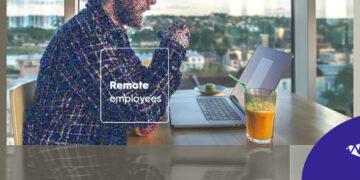Technology has completely transformed our work recently, especially since the COVID-19 pandemic. Companies are now leveraging digital tools to increase productivity and efficiency while adapting to the new normal of remote work.
Additionally, corporations are furthering the work practices that have been developed because of the coronavirus, like embracing remote and hybrid work agreements.
In this blog post, we’ll discuss some of the key ways technology affects everyday work, including distributed teams, digitalized customer-facing operations, digitalized business operations, flexible work schedules, reduced or eliminated non-essential travel, and redesign or even closed physical offices.
Remote and Hybrid Workforces: The Role of Distributed Teams and Digital Skills in This Era
Many companies have adopted a hybrid or remote work model in post-pandemic times to keep up with the changing times. This means that employees are working both remotely or in person when necessary.
In particular, the hybrid model allows companies to save on overhead costs while still being able to respond quickly to changes in the market. With a distributed team structure in place, communication and collaboration are optimized thanks to technology.
According to Carolyn Heinze, this is the great advantage of hybrid work, and she perceives this model as a ‘workforce structure’ that includes remote and on-site employees. In a hybrid work model, you’ll have:
- Less attrition
- Fewer or no commutes
- Increased productivity, enhanced collaboration,
- Expanded talent pool
Similarly, remote work is promising for any company in the US because it implies no commutes, increased productivity, and improved mental health. In contrast with hybrid models, nearshoring remote employees allows companies to save additional costs related to physical locations while working in a diverse, inclusive, digital workplace.
If you want to learn more about how outsourcing is a win-win for both owners and employees, read our blog post on nearshoring Mexican workers for US companies.
Learn more about the hybrid model by watching this interesting video.
Unlock The Benefits of Digitalized Customer-Facing Operations for Your Business
Digital technologies have increased customer satisfaction and engagement with businesses.
For example, companies are now leveraging AI chatbots for automated customer service interactions and using online stores for e-commerce transactions. Mobile apps can help businesses stay connected to customers even when they’re not physically present in a store or office building.
Regarding customer experience, remote workers have been quite effective in providing fast answers to clients. Also, customer service representatives may feel they have a perfect balance between work and personal lives when they go remote.
Digitalized Business Operations
Businesses are also using digital tools for internal processes, such as project management platforms like Asana or Basecamp, for collaboration between departments and stakeholders within an organization.
Cloud storage systems like Google Drive allow teams to securely access data from any device while giving company leaders visibility into how their resources are being used across their organization.
Additionally, savvy entrepreneurs have taken advantage of employee engagement software to evaluate their staff’s performance, provide incentives and rewards, as well as identify areas within the business that require attention.
Staggered or Flexible Work Schedules
Employees can now more easily manage their own work hours through flexible scheduling options offered by certain companies. This allows them to maintain a healthy balance between their personal life and professional responsibilities while still meeting deadlines set by management.
In addition, staggered shifts can help reduce office or work space overcrowding during peak hours throughout the day. This is how flexibility improves employee performance.
Reduction or Elimination of Non-Essential Travel
As more organizations switch to remote work models, there is less need for employees to travel for small business, such as attending conferences or meetings with potential partners or clients.
This helps free up time and money that would have otherwise gone towards planning trips and booking flights and hotels for employees who have already been given permission from management to travel on company time.
Redesign or Elimination of Physical Offices
Technology has also allowed many businesses to eliminate physical office spaces altogether as remote workers become more common than ever before! Companies no longer need dedicated spaces where groups of people gather daily because they can collaborate virtually using digital tools like Zoom or Skype instead.
This also eliminates enormous overhead costs associated with maintaining physical office space while still allowing teams of people working remotely all over the globe to stay connected without having ever met face-to-face!
Moreover, technology and culture become drivers of any company in post-pandemic times.
If you want to learn more about these drivers, read our post!
Conclusion
The implications of technological advancements on organizational operations are vast and far-reaching. Companies that take the initiative to adopt these new methods, technologies, and tools in their workplaces will undoubtedly be set up for success.
Not only will they be able to save time, money, and resources spent on non-essential tasks, but they will also experience an uptick in employee satisfaction and productivity as a result. Further, employees can benefit from the flexibility of remote work and reduced or eliminated physical office settings that come with these digital tools.
All of this means that companies are now better positioned than ever before to thrive in 2023 and beyond because of the advantages that technology provides them. With cloud storage systems and AI chatbots, distributed teams, staggered or flexible work schedules, and digitalized customer-facing operations, organizations have never been more empowered to succeed.
Our company is a full-service staffing agency specializes in outsourcing remote employees based in Mexico. A business model designed for US companies.














